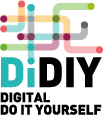Are you a maker?

Making creates a supportive community of learners that can leverage the interests and skills of each member of the group towards shared goals. Making has been organized to create supportive communities of practice and include encouraging collaboration and sharing. The main characters of a maker are:
- intrinsically motivated;
- takes risks and iterates from “failures” to achieve success;
- collaborates and gives advice and guidance to her peers: makers are often more interested in open sharing and exhibition, not simply competition.
The DiDIY Project has investigated the transformations that the Makers Movement, seen as a part of the more general DiDIY phenomenon, is producing in society, and how Makers may maximize the positive impacts of DiDIY on european society, and minimizing the negative ones.
To understand this side of DiDIY, and what should be done about it, we suggest you to look at the following studies, proposals and other resources by the DiDIY Project, listed here from the least to the most complex:
FACTS SHEET(s) on: making and Digital DIY
DiDIY VOCABULARY KEYWORDS: maker culture, DiDIY culture and maker movement
VIDEOs:
The parts of the DiDIY Guidance Manual about:
- main, long-term effects of DiDIY (p. 25)
- main DiDIY Stakeholders (p. 96)
Examples from the DiDIY POLICY PATTERNS wiki:
- Avoiding being sued for patent infringement
- Sharing Without Licensing
- DiDIY requires thinking about how to manage new sources of risk
- How to promote safety in the of DiDIY products
DiDIY Project Official Deliverables:
- DiDIY dominant legal challenges and solutions practised
- Open business models and legal practices of DiDIY hardware technologies
- Report about DiDIY risks, synergies and education
DiDIY KNOWLEDGE FRAMEWORK:
See in particular section 3 on the main features of DiDIY:
- 1.1. DiDIY: a human-centric phenomenon
- 3.1. DiDIY and the role of individuals
- 3.2. DiDIY and the role of communities
- 3.3. DiDIY and the role of technology
- 3.4. DiDIY and the role of design
- 3.5. DiDIY and the role of ethics
DiDIY Guidance Manual:

